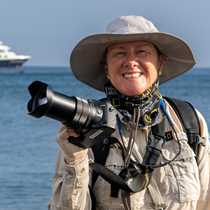Santa Cruz Island
This morning we got off to a great start – it wasn’t raining but the clouds held the sun at bay. A brief exploration of Puerto Ayora oriented everyone to its layout with some of our guests walking as far as the fishermen’s wharf to see if a catch had come in yet, and it had! So stories came back of sea lions and brown pelicans vying for the attention of those fileting the fish…hoping against hope for a head or any extra bits and pieces that might make their way in their direction (they did).
Soon we were in buses heading up into the lush highlands of Santa Cruz. This island is used as the textbook example of vegetation zones in Galápagos. We drove from the littoral zone into the arid zone followed by the transition zone and finally into the Scalesia zone. Being the rainy season, everything was green and so the change was subtle, but easily seen all the same when one knew what to look for. We lost the prickly pear cacti down below and found ourselves surrounded by tall trees, mostly introduced because we traveled through the agricultural area, but interesting all the same. Many people haven’t really had the chance to see Cuban cedars, banana, papaya, breadfruit, guava, guayaba, balsawood, bamboo and coffee plants, so it was an eye-opener to see these along the road.
The zone we were interested in is the Scalesia zone, where the predominant tree in times past would have been the famous Scalesia, a genus of plants descended from the sunflower family, now very much changed in appearance from that distant ancestor. Traditionally Scalesia pedunculata covered a vast area, creating a canopy of uniform height; elfin-like in the quantities of mosses, ferns, orchids and other epiphytes dependent on this endemic plant. The early colonists found out quickly that the best soils were to be found here, and so this became the agricultural area. Today Scalesia still can be seen – in fact more and more as reforestation projects advance and educational programs invite and encourage the planting of these as shade trees for coffee groves.
We reached our destination with a short stop to see the entrance to a lava tube. This is where a stream of lava comes rolling out of a fissure during an eruption, and finding the path of least resistance, moves downhill. The outer crust cools first, maintaining the inner flow hot and fluid. Many times this leaves a tunnel of lava behind, and millions of years of vegetation growth on top cover them until the roof collapses. Such was the one we visited, made accessible by the owners of the property (fortunately, otherwise ropes might have been needed!).
However, our main focus was still ahead: Galápagos giant tortoises. These enormous reptiles have a migration pattern attuned to the rainfall. They are free to wander and follow their heart’s desire, which is mainly food, warm temperatures and breeding possibilities (not necessarily in that order). At this time of year, the vast majority are down in the lowlands where all three opportunities await them: warm temperatures (which for reptiles is nice), food (because the arid zone has greenery due to the rains), and breeding potential because that’s where everyone else with a carapace is hanging out. We were fortunate in finding at this altitude some youngsters (about a foot long and a foot high) as well as some enormous individuals (one must have weighed well over 500 lbs / 250 kilos) who hadn’t left for the lowlands. This particularly humongous male was probably around when the H.M.S. Beagle was in the area back in 1835; the scutes on his back were completely smooth from time and the elements. No growth rings were visible at all.
Lunch was spent in a lovely highland restaurant called Altair where two barn owls had taken over one of the changing stalls near the pool as their personal space. The door was locked (“Do Not Disturb”, please! Nap-time in progress).
The afternoon had us visiting the tortoise-rearing center operated by the Galápagos National Park; the little hatchlings were in their enclosures, some as young a few months old. The big ones were from various islands and races, with special attention being paid to Lonesome George (with his new girlfriends in place) and Diego, our prodigal tortoise who spent years in San Diego before making his way home. With our luck holding and the cloud cover keeping the temperatures down, yet not raining, everyone was happy – people and tortoises alike. What a day!




